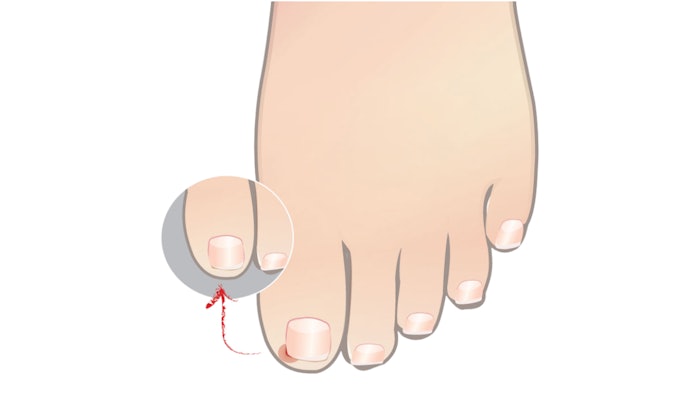
Pedicure season is here, and clients will be coming in droves for foot services.
Unfortunately, ingrown toenails are a common issue, causing clients pain and swelling, and sometimes leading to infection. While techs are not permitted to treat this condition, nail professionals can help prevent ingrown nails. Here, expert advice for averting this toenail bummer this summer.
1. DO remember, techs aren’t doctors.
"If a client presents an already ingrown nail, it’s not for the nail technician to touch," says Karen Hodges, co-owner of NailCare Academy in Fort Myers, Florida. “We are in the ‘beautification’ business only.”
However, after a client has been released from her physician’s care, techs can cosmetically address any foot- and nail-care issues.
2. DON’T service a client with inflammation, injury or infection.
Inspect the feet carefully before ever starting a service, says Hodges. If you witness any redness, swelling or weeping around the nail plate, don’t proceed with the pedicure. Refer them to a medical professional instead.
3. DO use the right tools.
Vicki Malo, president of the North American School of Podology in Toronto, Ontario, Canada, prefers flat-edge nippers (nothing with an angle) and slightly curved toenail clippers.
An ingrown nail file is another valuable tool; its thin tip with very fine grit can be used to smooth the nail’s curved edges. Watch the size of your tools, as well. For instance, using a too-large curette under the toenail can generate too much pressure, lifting the nail plate and creating an area ripe for fungus, says Malo.
4. DON’T cut the nail too short.
A client’s common reaction to an ingrown nail is to reach for the clippers and cut the nail short. However, now the outlying flesh of the toe can come up over the leading edge, forcing the nail downward into the sidewalls—causing an ingrown.
Hodges corrects this cycle by allowing the nail to grow long enough that it no longer digs into the distal portion of the toe. Before you can trim the nail properly, the nail should be long enough that trimming is possible, she says.
5. DO cut the nail in small cuts.
“Use small ‘nibbles’ as you work your way across the nail, rather than trying to take the length down in a single ‘bite,’" says Hodges.
Avoid flattening the nail, which can cause pain and splitting on the sides of the free edge, especially when nails are thick or tough.
6. DON’T cut into the corners.
The nail should be cut and filed straight across. Leave the corners alone so they grow out and away from the hyponychium, says Hodges.
That being said, sharp corners can cut into the skin, says Malo, so use a fine file to gently take the sharpness off the corners without rounding the nail.
7. DO care for the skin around the nail.
Keeping the area in the vicinity of the nail healthy, supple and properly moisturized can help prevent ingrowing, says Hodges.
Use an exfoliating scrub to keep calluses at bay and encourage clients to moisturize at home.
8. DON’T forget client education.
Discuss with your clients the importance of proper footwear.
Poorly fitting footwear or extremely pointed styles can push the toenails into the nail groove area, says Malo.
Also, remind clients to wear protective footwear, such as steel-toe boots, if working in an area where there’s a risk of injury.
9. DO get clients on a program for trimming their nails.
If a client is ingrown prone, get them to commit to eight weeks without trimming their nails at home and a total of three pedicure treatments that focus on growing out and reshaping the toenails, says Hodges.
“Giving a deadline helps, but I’ve found getting someone to do something for three weeks usually ingrains it into their lifestyle," Hodges adds.
This article was first published in the July 2017 issue of Nailpro.











